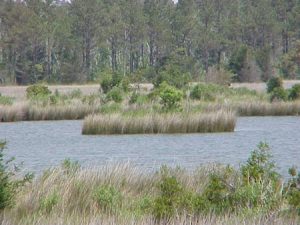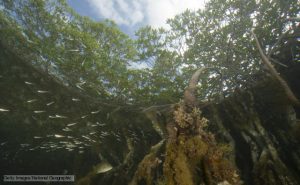Sea levels have been rising over the years due to water expansion and glaciers melting (Jacob et al, 2012). Unfortunately unlike Blondie not all of our coastal systems can ‘hold on’ and survive this. There have been effects on wetlands (Scavia, 2002) such as marshes and mangroves by:
- Inundation (flooding)
- Salt water intrusion
- Erosion
Marshes

Rising sea levels increase the frequency and duration of tidal flooding in marshes (Titus, 1988). If these marshes are supplied with additional sediment then they can retreat landwards and keep up with sea level rise. However if they aren’t Usain Bolt enough to outrun sea level, the marsh grass drowns, soil erodes and the system is lost and often becomes open water. This usually occurs in salt water coastal marshes (Scavia et al, 2002).
Another effect of rising sea level allows salt water to move upstream and inland to the freshwater marshes, causing them to transition into a brackish (slightly salty) marsh. Often, a response is to replace freshwater species with more salt tolerant species, therefore changing the biodiversity and functioning of the system.
Marshes are very important as nursery grounds, giving protection to marine invertebrates and fish larvae and are also an important food source for aquatic birds such as sandpipers as well as other large animals (Titus, 1988). They are also vastly important for humans as they provide services associated with waste treatment and productivity. These processes will likely be affected with the reduction of salt marshes and the transition of fresh water marshes to brackish (Craft et al, 2009).
Mangroves

Mangroves adjust to a rising sea level by moving into areas of higher elevation. This movement however can be limited by obstacles, steep gradients and the amount of sediment accumulation (Gilman et al, 2008). Different species have different colonisation speeds, leading to competition between species. This can cause some to become more dominant than others, affecting biodiversity. (Di Nitto et al, 2014).
Mangroves can’t always move faster than sea level rise and the increased flooding can cause roots to weaken, trees to die and the system to become open water. Even when they are able to move, many mangroves are losing elevation relative to sea level (Gilman et al, 2008) (Lovelock et al, 2015).
Mangroves are important:
- For supporting biodiversity
- As fishery nursery habitats
- For coastal protection
- For carbon uptake
and are therefore relied on by many human communities (Di Nitto et al, 2014). These effects are likely to get worse in the coming years and therefore more research should be carried out and protection plans put in place.
Scale model showing how mangrove forests protect the coast from wave erosion.
Overall wetlands are thought to be most affected on the Atlantic Coast of Central and North America, Caribbean islands, the Mediterranean and Baltic (Nicholls, Hoozemans And Marchand, 1999). So remember, wetlands aren’t just some soggy plants! They are vital ecosystems that have important functions and their loss could cause many issues especially in the coming years as sea level continues to rise.
References
Craft, C., Clough, J., Ehman, J., Joye, S., Park, R., Pennings, S., Guo, H. and Machmuller, M. (2009). Forecasting the effects of accelerated sea-level rise on tidal marsh ecosystem services. Frontiers in Ecology and the Environment, 7(2), pp.73-78.
Di Nitto, D., Neukermans, G., Koedam, N., Defever, H., Pattyn, F., Kairo, J. and Dahdouh-Guebas, F. (2014). Mangroves facing climate change: landward migration potential in response to projected scenarios of sea level rise. Biogeosciences, 11(3), pp.857-871.
Gilman, E., Ellison, J., Duke, N. and Field, C. (2008). Threats to mangroves from climate change and adaptation options: A review. Aquatic Botany, 89(2), pp.237-250.
Jacob, T., Wahr, J., Pfeffer, W. and Swenson, S. (2012). Recent contributions of glaciers and ice caps to sea level rise. Nature, 482(7386), pp.514-518.
Lovelock, C., Cahoon, D., Friess, D., Guntenspergen, G., Krauss, K., Reef, R., Rogers, K., Saunders, M., Sidik, F., Swales, A., Saintilan, N., Thuyen, L. and Triet, T. (2015). The vulnerability of Indo-Pacific mangrove forests to sea-level rise. Nature, 526(7574), pp.559-563.
Nicholls, R., Hoozemans, F. and Marchand, M. (1999). Increasing flood risk and wetland losses due to global sea-level rise: regional and global analyses. Global Environmental Change, 9, pp.S69-S87.
Scavia, D., Field, J., Boesch, D., Buddemeier, R., Burkett, V., Cayan, D., Fogarty, M., Harwell, M., Howarth, R., Mason, C., Reed, D., Royer, T., Sallenger, A. and Titus, J. (2002). Climate change impacts on U.S. Coastal and Marine Ecosystems. Estuaries, 25(2), pp.149-164.
Titus, J. (1988) Sea Level Rise and Wetland Loss: An Overview U.S Environmental Protection Agency.
[489 words]
Recent Comments